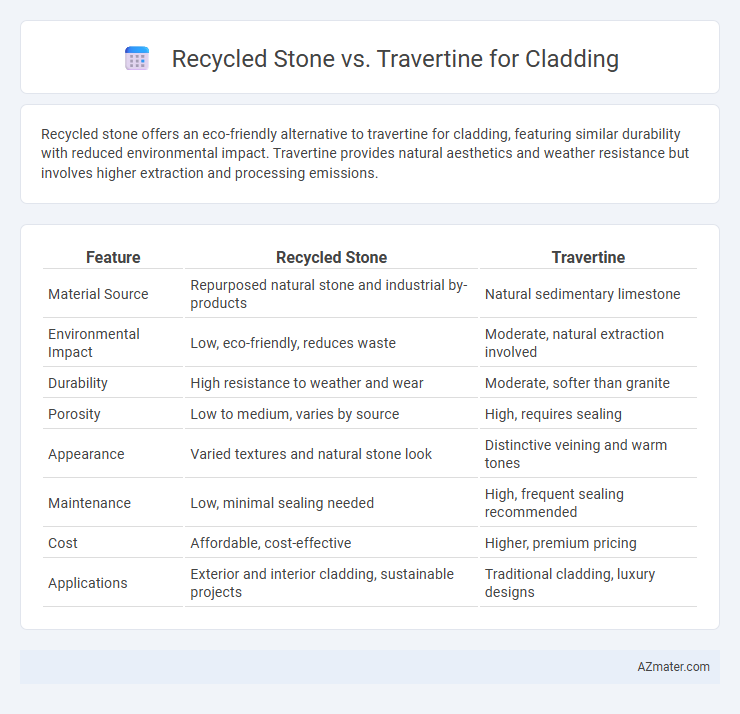Recycled stone offers an eco-friendly alternative to travertine for cladding, featuring similar durability with reduced environmental impact. Travertine provides natural aesthetics and weather resistance but involves higher extraction and processing emissions.
Table of Comparison
| Feature | Recycled Stone | Travertine |
|---|---|---|
| Material Source | Repurposed natural stone and industrial by-products | Natural sedimentary limestone |
| Environmental Impact | Low, eco-friendly, reduces waste | Moderate, natural extraction involved |
| Durability | High resistance to weather and wear | Moderate, softer than granite |
| Porosity | Low to medium, varies by source | High, requires sealing |
| Appearance | Varied textures and natural stone look | Distinctive veining and warm tones |
| Maintenance | Low, minimal sealing needed | High, frequent sealing recommended |
| Cost | Affordable, cost-effective | Higher, premium pricing |
| Applications | Exterior and interior cladding, sustainable projects | Traditional cladding, luxury designs |
Introduction to Cladding Materials
Recycled stone and travertine are popular cladding materials known for their durability and aesthetic appeal in architectural design. Recycled stone offers an eco-friendly solution by repurposing natural stone fragments, reducing environmental impact while maintaining structural strength. Travertine, a natural limestone formed in mineral springs, provides a classic, textured appearance with inherent porosity suitable for various indoor and outdoor applications.
What is Recycled Stone Cladding?
Recycled stone cladding is an eco-friendly building material made from repurposed natural stone fragments, offering sustainability by reducing quarrying waste and conserving natural resources. Compared to travertine, which is a natural sedimentary rock known for its durability and distinctive porous texture, recycled stone cladding provides a unique aesthetic with varied textures while promoting environmental responsibility. This cladding option is ideal for projects targeting green building certifications and seeking cost-effective alternatives without compromising on the natural stone appearance.
Understanding Travertine Cladding
Travertine cladding offers natural stone durability and timeless elegance, characterized by its porous texture and warm beige to cream tones ideal for facades and interior walls. Compared to recycled stone, travertine provides superior heat resistance and a unique veined pattern that enhances architectural aesthetics. Proper sealing is essential to protect travertine cladding from moisture and environmental wear, ensuring long-lasting performance and minimal maintenance.
Sustainability and Environmental Impact
Recycled stone cladding significantly reduces environmental impact by diverting construction waste from landfills and minimizing the need for quarrying raw materials, which preserves natural landscapes and reduces carbon emissions. Travertine, a natural limestone, involves extensive quarrying that contributes to habitat disruption and high energy consumption, although it is a durable and recyclable material. Choosing recycled stone supports circular economy principles and lowers the overall carbon footprint of cladding projects compared to traditional travertine options.
Aesthetic Differences: Recycled Stone vs Travertine
Recycled stone cladding offers a unique, textured appearance with natural variations and an eco-friendly character, often showcasing irregular shapes and a rustic charm. Travertine provides a smooth, elegant finish with consistent veining and a warm color palette ranging from ivory to deep caramel, contributing to a classic, timeless aesthetic. Choosing between recycled stone and travertine depends on the desired visual impact, with recycled stone leaning towards a rugged, sustainable look and travertine emphasizing polished sophistication.
Durability and Maintenance
Recycled stone cladding offers high durability due to its dense composition and resistance to weathering, making it less prone to chipping and cracking compared to natural travertine. Travertine requires regular sealing and maintenance to prevent staining and erosion, especially in outdoor applications exposed to moisture. The low-maintenance nature of recycled stone reduces long-term upkeep costs and enhances longevity in harsh environments, outperforming travertine in both durability and maintenance efficiency.
Cost Comparison
Recycled stone cladding generally offers a more cost-effective solution compared to travertine, with prices often ranging from $10 to $25 per square foot versus travertine's $20 to $50 per square foot. Installation expenses for recycled stone can be lower due to its lighter weight and easier handling, reducing labor intensity and time. Maintenance costs also favor recycled stone, as its durable composition resists staining and weathering better than the porous surface of travertine.
Installation Methods and Challenges
Recycled stone cladding requires specialized adhesives and careful surface preparation due to its irregular shapes and varied thickness, which can complicate installation and extend project timelines. Travertine, often available in uniform slabs, allows for more straightforward installation using traditional mechanical fixing or mortar methods, but its porous nature demands sealing to prevent staining and moisture ingress. Both materials pose challenges: recycled stone demands skilled labor for fitting and alignment, while travertine's fragility requires careful handling to avoid cracking during installation.
Suitable Applications for Each Material
Recycled stone offers an eco-friendly option ideal for sustainable building projects, garden walls, and decorative facades where environmental impact is a priority. Travertine provides a classic, elegant finish suitable for high-end residential and commercial cladding, especially in areas requiring durability and a natural stone aesthetic. Both materials excel in different contexts: recycled stone supports green construction and cost-effectiveness, while travertine ensures timeless beauty and structural reliability.
Making the Right Choice: Key Considerations
Recycled stone offers an eco-friendly option for cladding with lower environmental impact and unique aesthetic variations compared to traditional travertine, which is valued for its natural porous texture and durability. Key considerations include the project's sustainability goals, budget constraints, and desired visual effect, as recycled stone often provides cost savings and a distinct look while travertine demands more maintenance but offers timeless elegance. Assessing weather resistance, installation requirements, and long-term performance ensures the right material choice for exterior or interior cladding applications.

Infographic: Recycled stone vs Travertine for Cladding
 azmater.com
azmater.com